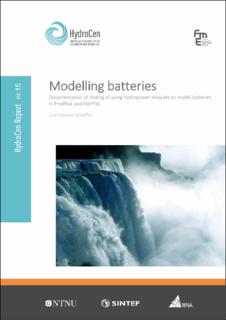| dc.contributor.author | Schäffer, Linn Emelie | |
| dc.date.accessioned | 2020-09-04T09:23:41Z | |
| dc.date.available | 2020-09-04T09:23:41Z | |
| dc.date.issued | 2020 | |
| dc.identifier.isbn | 978-82-93602-16-3 | |
| dc.identifier.issn | 2535-5392 | |
| dc.identifier.uri | https://hdl.handle.net/11250/2676371 | |
| dc.description.abstract | The report documents a test of how pumped storage functionality can be used to model batteries in SINTEFs long-term models. Firstly, optimal operation of a battery in a price taker setting is simulated using the ProdRisk model. The exogenous prices are taken from the Low Emission Scenario [3]. This first test was mainly done to build competence on the problem of modelling batteries. The results show that it functions very well being aware of the assumptions of the model, the most important being prices known for the whole week. In the second test, two batteries were put into our Low Emission dataset of Northern Europe 2030, with one battery in Germany and one UK. The dataset was simulated using the EMPSW model that uses formal optimization on individual plant level for the weekly marked clearing problem. EMPSW model gives reasonable results and show that batteries with relative short-term storage capacity can considerably reduce the number of price spikes. As for ProdRisk, EMPS also assumes everything known for the whole the week. In addition, the testes identified the weekly end value setting of battery storage as an improvement area. Especially, when the batteries are put into areas without regular hydro storages. | en_US |
| dc.language.iso | eng | en_US |
| dc.publisher | Norwegian Research Centre for Hydropower Technology | en_US |
| dc.relation.ispartofseries | HydroCen Report;15 | |
| dc.title | Modelling batteries - Documentation of testing of using hydropower modules to model batteries in ProdRisk and EMPSW | en_US |
| dc.type | Research report | en_US |
| dc.description.localcode | © SINTEF 2020. The publication may freely be cited with source acknowledgement. | en_US |
